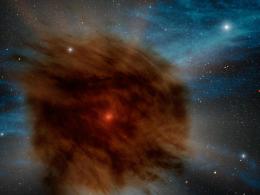
An artist's rendering of a supernova smothered in its own dust.
While the San Francisco 49ers and the Baltimore Ravens were butting heads and other body parts a couple of Sundays ago, they were simultaneously taking a whole different type of pounding, though they didn’t know it. Pouring down on them from the skies was a kind of cosmic rain—or, more accurately, a spray of cosmic bullets. During each second of the game, the gridiron was slammed with between 5,000 and 6,000 subatomic particles, on average, screaming in from space. Once a second, in fact, around the clock, every square yard on Earth is hit by one of these so-called cosmic rays. And while scientists have known about them for a century or so, it’s only now that they’re figuring out where the ubiquitous form of energy actually comes from.
The answer, a team of physicists just reported in Science, is that most cosmic rays are blasted from the shock waves of supernovas — stars whose death throes trigger the most powerful explosions in the Milky Way. It’s something scientists have long suspected, but now they have the smoking gun, thanks to painstaking observations with the orbiting Fermi Gamma Ray Observatory.
It’s certainly taken them long enough. Back in the early 1900’s, physicists discovered a mysterious, invisible form of radiation that they couldn’t explain. It was stronger at the top of the Eiffel Tower than on the ground, and stronger still a mile or or more into the sky, as the scientists discovered when they lofted detectors. “The results of my observation are best explained,” wrote the Austrian physicist Victor Hess in 1912, “by the assumption that a radiation of very great penetrating power enters our atmosphere from above.”
(MORE: The Milky Way’s Mystery Cloud)
By the 1930’s, it was clear that the radiation was made up of subatomic particles — mostly protons, but with a smattering of electrons, streaking in from space at a fair fraction of the speed of light. But it’s never been entirely clear what sort of cosmic cannon could shoot particles across the galaxy with such energy.
Supernovas have been the obvious suspect for a long time. The blast of hot gases they send out in an explosive shockwave are clearly powerful enough to accelerate particles to near lightspeed, and it would seem easy enough to nail down the final piece of evidence that would prove the theory definitively: Just note what direction cosmic rays are coming from, look to see if there’s the glow of a supernova remnant, or SNR, in that part of the sky and you’ve got your answer.
It’s not quite that simple, though, says co-author Stefan Funk, of the Stanford Linear Accelerator Center, in California. “If you had cosmic-ray eyes,” he explains, “the sky would look very boring, because cosmic rays come from all directions.” What he means is that you can’t follow the rays back to their source because protons and electrons curve when they travel through magnetic fields. And since magnetic fields permeate the spaces within the stars, a cosmic ray that seems to be coming in from the direction of the Big Dipper, say, might actually have started out in Sagittarius, or almost any other part of the sky.
(MORE: The Ancient Space Storm That Struck the Earth)
To prove the supernova connection, the observers had to be creative. As protons are blasted into space by supernovas, some will escape, but others will slam into hydrogen atoms, creating a burst of gamma rays, a highly energetic form of light. Sure enough, when the authors of the paper analyzed readings from the orbiting Fermi Gamma Ray Telescope as it swept across the sky, they managed to identify gamma rays from no fewer than 50 SNR’s.
That still didn’t solve the mystery, though, because supernovas produce gamma rays in more than one way. But it turns out that the gamma rays generated by a speeding proton have a unique mix of energies. And that’s what the scientists were able to measure — for two of the SNR’s, anyway. “These two are the brightest,” says Funk, “and while we hope to make these measurements for some of the others, we won’t be able to do all of them.”
So gamma rays emanating from SNR’s come from speeding protons. Cosmic rays are made of speeding protons. Case closed — or almost, anyway. It’s still circumstantial. “There are other phenomena that in principle could also be the source of cosmic rays,” says Funk. Plain old novas, a less powerful type of exploding star, could technically do it. So could fast-rotating neutron stars, or collisions between the stellar winds of massive stars.
But that’s only in principle. These other kinds of proton-makers would have to put pretty much 100% of their energy into creating cosmic rays. SNR’s can do it without even breathing hard. “We need to do more studies,” says Funk, dutifully. Maybe, but it’s hard to imagine the verdict will be overturned.

